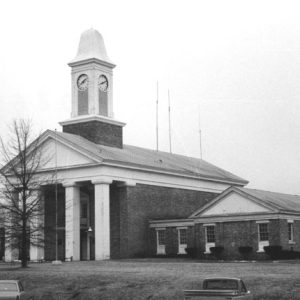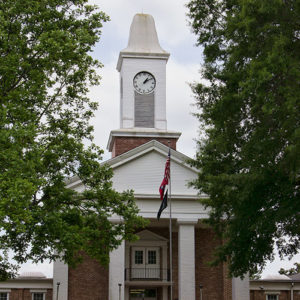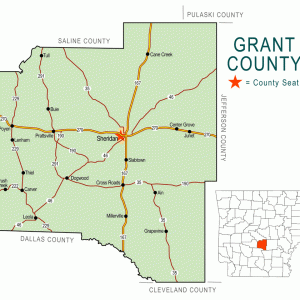calsfoundation@cals.org
Sheridan (Grant County)
County Seat
| Latitude and Longitude: | 34º18’25″N 092º24’04″W |
| Elevation: | 278 feet |
| Area: | 12.03 square miles (2020 Census) |
| Population: | 4,920 (2020 Census) |
| Incorporation Date: | August 26, 1887 |
Historical Population as per the U.S. Census:
|
1810 |
1820 |
1830 |
1840 |
1850 |
1860 |
1870 |
1880 |
1890 |
1900 |
|
– |
– |
– |
– |
– |
– |
– |
42 |
184 |
210 |
|
1910 |
1920 |
1930 |
1940 |
1950 |
1960 |
1970 |
1980 |
1990 |
2000 |
|
481 |
695 |
1,590 |
1,338 |
1,893 |
1,938 |
2,480 |
3,042 |
3,098 |
3,872 |
|
2010 |
2020 | ||||||||
|
4,603 |
4,920 |
Sheridan, the county seat of rural Grant County, which lies approximately thirty-four miles south of Little Rock (Pulaski County), was named after Union general Philip Sheridan when the town was incorporated twenty-two years after the Civil War. Today, Sheridan is a growing community with expanding industries and one of the state’s largest school districts.
Pre-European Exploration through European Exploration and Settlement
The first inhabitants of Grant County are believed to have lived as early as circa 12,000 BC. Three Indian mounds on the John Ratliffe farm about twelve miles west of Sheridan were excavated by the late Francis Posey, an early settler, in the 1800s. He removed parts of a skeleton, ashes, projectile points, shells, and a piece of a big clay pipe. Roughly 200 archaeological sites exist in Grant County, including prehistoric campsites and settlements from many cultures and historic periods.
After the death of Hernando de Soto, members of his party probably crossed Grant County trying to find their way to Mexico; they left no identifiable marks of their journey. Caddo farmsteads near the Saline River in the western part of the county were occupied until about 1700 AD.
Louisiana Purchase through Early Statehood
In 1818–1824, Grant County was a part of the Quapaw reservation stretching from Arkansas Post (Arkansas County) in the east to the Saline River, then north to Little Rock (Pulaski County) and back to the post. By 1833, most of the Quapaw had left this region, having ceded their land to the United States.
Dr. Richard C. Rhodes arrived in the county in 1849 from Roberson County, North Carolina. He built a large two-story log home south of Sheridan, which still stands off U.S. Highway 167 South, although it is in very poor condition. The first post office in Grant County was probably the one called Lost Creek, and among its postmasters was Joab Pratt, a preacher from Alabama. This office was a few miles southwest of Sheridan in what became Turin, known as the Philadelphia Community.
Civil War through Reconstruction
In 1863, Union general Frederick Steele captured Little Rock and proceeded south in the 1864 Camden Expedition. The expedition failed, and Steele was forced to retreat toward Little Rock. When the Union army reached Jenkins’ Ferry on the Saline River near Sheridan, the Union wagon train bogged down, and Confederate general E. Kirby Smith attacked the rear of Steele’s command. Steele managed to cross the river, but at a high cost.
During Reconstruction, taxes were high, and a desire emerged in 1868 for a more convenient means of doing county business. All legal business had to be conducted at Benton (Saline County) or Pine Bluff (Jefferson County), and the journey was difficult. The act creating Grant County was signed by Governor Powell Clayton on February 4, 1869. The storehouse of Enoch H. Vance Sr., located on the Pine Bluff Road near present-day Sheridan, was used for early organizational meetings. For a permanent county seat, the commissioners accepted as gifts two adjoining tracts of land from Littleton Meeks Veazey and A. N. Harris. The City of Sheridan was incorporated on August 26, 1887, and the first town council meeting was held in the courthouse on October 14, 1887. County business continued to be transacted at Vance’s store for about a year, after which county officials occupied a storehouse on the corner of Main and Center streets.
All four courthouses, including the two built in the twentieth century, have been located at this site. The first courthouse, built in 1871 at a cost of $3,500, burned just a few years later on March 13, 1877, and the courthouse and most county records were destroyed. A temporary courthouse was fashioned from a building on the northwest corner of Center and Oak streets, still on the same lot. In 1880, a second courthouse was completed at a cost of $1,680.
In 1885, a brick jail costing $3,400 replaced the earlier frame structure and served the county until 1938.
Post Reconstruction through the Gilded Age
In 1881, the first newspaper in the county was established at Sheridan. First called the Sheridan Spy, it was renamed the Sheridan Headlight. The paper is the oldest surviving business in Grant County, as well as its only newspaper.
In 1886, Robert M. Rodgers established the Sheridan Commercial Normal School. The school set the pattern for a college that was later established at the turn of the century in Sheridan, the Missionary Baptist College, which was located on the campus of what became the Sheridan Freshman Academy. The college conducted classes until about 1934.
In 1898, an African American man named Amos Neely was lynched for allegedly assaulting a white woman. In 1903, an African American man named Ed McCollum was lynched for having allegedly assaulted a police officer.
Early Twentieth Century
In 1913, the Sheridan School District erected the first brick school building in Grant County. In 1936, the Sheridan School District purchased the Missionary Baptist College property for $7,500 and renovated it as Sheridan Elementary School. After the college building burned in November 1957, what later became the freshman academy was constructed for use as an elementary.
On January 19, 1922, the Sheridan Headlight announced the organization of the Ku Klux Klan (KKK) in Grant County, noting that the members and meetings were unknown. In March 1922, the KKK demonstrated with a parade through the streets of Sheridan that drew one of the largest crowds of its time. However, in the late 1920s, the Klan declined rapidly in popularity in the state.
Oak Street was the first road to be graveled in Sheridan; this was done in 1905. In 1929, the Sheridan Volunteer Fire Department was organized. The department’s first motorized fire truck was a 1939 six-cylinder Chevrolet, which is on display at the Grant County Museum. A water system was developed in Sheridan in the 1930s by private enterprise. In the late 1930s to early 1940s, the City of Sheridan bought the system and began servicing city residents.
A Civilian Conservation Corps (CCC) camp known as P-61 or Camp Sheridan was built east of Hurricane Creek at Ico (Grant County) in 1933. It contained barracks and other buildings for several hundred unmarried men, members of companies 783 and 1752. Camp P-61 was involved in forestry work, including building trails, fire towers, cabins, fire breaks, and bridges. The men also installed telephone lines and cleared timber. Local trails built by the CCC included Koen, Hula Bar, Holiman, Baxter, Bruce, and Caple, of which some were originally old logging trams. In 1940, the CCC built a residence, office building, garage, and storehouse for use as headquarters of Unit 7 of the Arkansas Forestry Commission. Camp Sheridan closed that same year.
Few black families lived in Sheridan until the 1920s, when those numbers increased due primarily to the arrival of forest industries that employed black workers. At that time the only formal education available to black children in the area was from the teachings of Melissa Dorn, wife of the Reverend Henry Dorn, a local Baptist minister. Another minister, one Rev. Nall, later encouraged the black parents to organize in the fall of 1936 and request the cooperation of the Sheridan School Board. The board employed a teacher, and thirteen students enrolled when the school year opened in October 1936. They met in the Stranger’s Rest Baptist Church, located in the black community adjacent to the J. L. Williams & Sons Mill. A separate one-room school known as Lambert Wing School was constructed nearby in 1940, and another teacher was employed. Another room was added and two more teachers were hired in 1951–1952.
World War II through the Modern Era
In May 1954, the Sheridan School District was the first district in Arkansas to vote to integrate its schools; however, that decision was rescinded shortly afterward due to public pressure. On May 21, 1954, four days after the Brown decision, Superintendent A. R. McKenzie and the Sheridan School Board announced that black pupils would be admitted to the upper six grades of its school in the fall. The Lambert Wing School was to be maintained for elementary students. The board confined the immediate integration to the upper grades because of the heavy load of white students expected in the lower grades.
Word spread quickly, and an opposition group made its presence known. Bowing to pressure from businesses and some church leaders, the school board rescinded the decision to integrate. The school board records do not mention the Lambert school again until March 1957. No other reference in school documents was made regarding the school or the Supreme Court decision.
A family relocation plan was enacted to reduce the number of black students in the district, but many details are not known. J. L. Williams & Sons Lumber Mill, which employed many black families in the area, informed its black employees that the land on which the company-owned housing was located was needed for mill expansion. Black employees were told they would retain their jobs and could take ownership of the houses, which had to be moved out of the area, with the mill assisting with moving expenses. The number of black families in the district was thus reduced, ending the board’s obligation to integrate.
In the fall of 1954, the remaining high school students at Lambert Wing School were transported to Pine Bluff. By 1961, all black families had apparently left the Sheridan area, and the Lambert Wing School closed.
A businessman named John Thurman McCool made front-page news when he was mysteriously murdered outside of Sheridan in 1962. His involvement in a case of forgery, as well as the violent means of his murder, raised suspicions of possible mob involvement.
A brick courthouse built in 1909 at a cost of $55,340 was condemned as unsafe during the 1960s and was replaced in 1964. The courthouse is positioned in the center of Sheridan and serves as a symbol of Grant County.
The 2006–2007 enrollment for Sheridan School District was over 4,300, with 300 teachers, administrators, librarians, counselors, and approximately 298 support staff members. The district encompasses all of Grant County, with the exception of Poyen and parts of southern Saline County.
Industry
Grant County is known for its timber industry, which took hold as early as the 1880s and has thrived ever since. At one time, the timber industry was the largest employer in the county. Although the timber industry in Grant County still employs many people, growth and technology have reduced the need for so many workers. Many Sheridan residents now work in other industries and professions.
Other industries include Kohler Faucet Operations, which added a distribution center in 2005, as well as Centria, Anthony Hardwood Composites, Shippers Paper Products Co., and Sheridan White Rock.
Attractions
Based around the county’s deep roots in the timber industry is the annual Timberfest celebration, which includes the state lumberjack competition, as well as arts and crafts; festival food vendors; live music; and numerous civic, church, and business booths.
The Grant County Museum is located in Sheridan on Shackleford Road.
On March 12, 1943, the nine-man crew of a B-17F Flying Fortress perished in a crash near Sheridan; in 2015, the crash site became home to a memorial park honoring the nine airmen, as well as Union and Confederate Civil War soldiers who fought in the Engagement at Jenkins’ Ferry and soldiers from Grant County who have been killed in action since World War I.
Notable Residents
John McClellan served in the U.S. Senate for thirty-five years, during which time he was one of the Senate’s most powerful members and a proponent of large federal projects. Bob Lancaster, newspaper columnist and author of several books, was born in Sheridan.
For additional information:
Goolsby, Edwin L. Our Timberland Home: A History of Grant County. Little Rock: Rose Publishing Company, 1984.
Grant County Museum. Sheridan, Arkansas.
The Sheridan Headlight. Grant County Bicentennial Issue. April 29, 1976.
The Sheridan Headlight. Sheridan’s 100th Birthday Issue. October 7, 1987.
Wilson, Roy L. Sheridan and Grant County. Charleston, SC: Arcadia Publishing, 2012.
Millie J. McClain
The Sheridan Headlight
 Grant County Bank
Grant County Bank  Grant County Courthouse
Grant County Courthouse  Grant County Courthouse
Grant County Courthouse  Grant County Map
Grant County Map  Sheridan Street Scene
Sheridan Street Scene  Sheridan Street Scene
Sheridan Street Scene  Sheridan Train Depot
Sheridan Train Depot  Timberfest Mural
Timberfest Mural 




Comments
No comments on this entry yet.